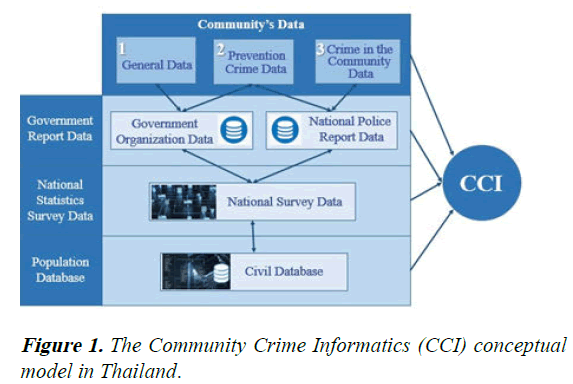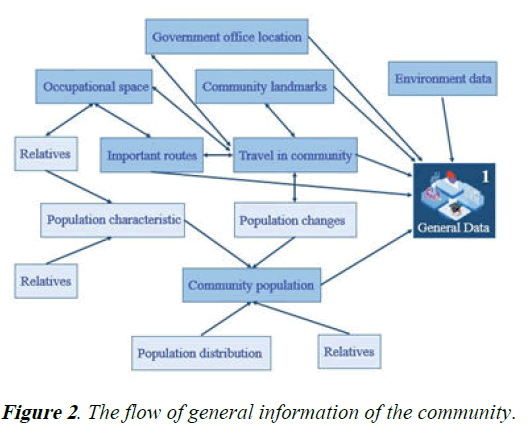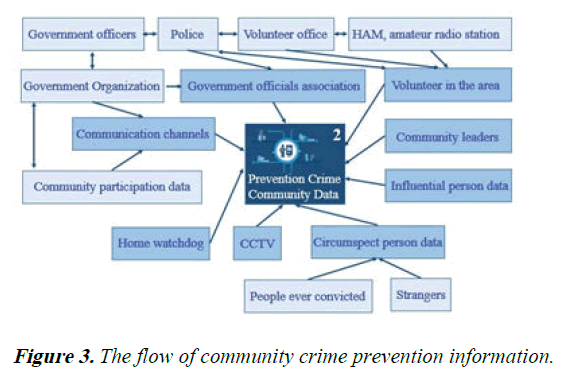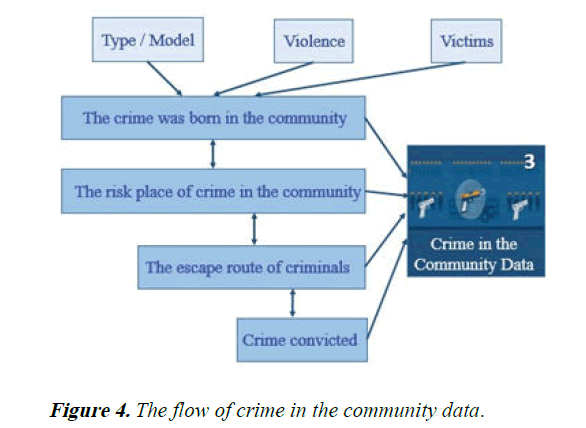Research Article - Addiction & Criminology (2023) Volume 6, Issue 5
The data of crime civil opinion to develop Community Crime Informatics (CCI) model in Thailand.
Sangtien Youthao*
Department of Social Sciences, Mahidol University, Salaya, Thailand
- Corresponding Author:
- Sangtien Youthao
Department of Social Sciences,
Mahidol University,
Salaya,
Thailand,
E-mail: sangtien.you@mahidol.ac.th
Received: 07-Jun-2021, Manuscript No. AARA-23-33198; Editor assigned: 10-Jun-2021, PreQC No. AARA-23-33198 (PQ); Reviewed: 24-Jun-2021, QC No. AARA-23-33198; Revised: 04-Aug-2023, Manuscript No. AARA-23-33198 (R); Published: 1-Sep-2023, DOI: 10.35841/aara-6.5.168
Citation: Youthao S. The data of crime civil opinion to develop Community Crime Informatics (CCI) model in Thailand. Addict Criminol. 2023;6(5):168
Abstract
A study of Thailand’s semi-urban community by mixed research from 400 samples and 10 key informants. The factors that affected the strong community are the performance and involvement of government officials and crime prevention. The conceptual model of community crime informatics in Thailand consisted of fundamental data including general information, the statistic of crime prevention and occurrence within the community; data report and collection from government agencies; data from surveys and questionnaires and crime databases at a national level. The four parts of the structures are connected to each level and integrated into the community crime informatics.
Keywords
Community information, Community crime data, Community crime informatics, Crime model.
Introduction
Countries around the world recognize the importance of information-related crimes is attempts to obtain information relating to crime in the country. As can be seen from the examples given in the United States and England and Wales trying to carry out the crime data compiled by the police and the survey [1].
Currently, the data are more important because of more development, the focus should be shifted to more fact-based information. Community development must be based on the reality of the community. Important principles in sustainable community development rely on the further understanding of the data and information of the community. The data from the study of many scholars who pointed out that the Community Informatics (CI) system is an important tool in the selfdevelopment of the community to provide it with data, information and knowledge for solving community problems and sustainability planning. The information about community action is, therefore, necessary to proceed in a systematic way to get up-to-date information that is appropriate to use in development in various fields [2].
Crime information is the important information to be used in the solution to the people in the public. Which have increased both in volume and violence continues. The data of crime civil opinion studies, therefore, need to take serious action. This will lead to the development of the conceptual model "Community Crime Informatics (CCI)" to solve the crime of the community in Thailand [3].
Objectives:
• To study the attitudes which the community has developed with regards to crime prevention, the performance, and involvement of government officials, community safety and strong community.
• Find the factors from the crime prevention, the performance and involvement of government officials and community safety that affecting the strong community.
• To develop a conceptual model. "Community Crime Informatics (CCI)" in Thailand.
Materials and Methods
Scope of the study
The scope of this study focuses on the attitudes which the community has developed with regards to the following four aspects of crime Informatics; crime prevention, the performance and involvement of government officials, community safety and a strong community to develop community crime informatics conceptual model in Thailand [4].
The samples that used for responses questionnaires by 400 samples and meeting a group of key informants of 10 people.
Expected benefits:
• To know the level of the attitudes which the community has developed with regards to the following four aspects of crime informatics.
• Create a conceptual model. "Community Crime Informatics (CCI)" in Thailand.
• Can be applied academically between information management and criminology to community development.
Study design
This study used the mixed method research from the tools that used in this study were:
• Questionnaires
• Focus group form
This study has no conflicts of interest to disclose and research design, sample method and tools of these have the certificate of MUSSIRB approval from the Mahidol university committee for research ethics in full compliance with international guidelines of human research protection such as declaration of Helsinki, The Belmont report and CIOMS guidelines [5].
Collecting data
The storage of data in this study is divided into 3 parts. The first part will study various academic writings and attitudes about crime prevention; the performance and involvement of government officials, community safety and strong community. The data of the attitude of the community about crime as a basis to develop a conceptual model. "Community Crime Informatics (CCI)" in Thailand. In the second part to collect data from a questionnaire in the sample from Thailand's metropolitan area consists of the following 5 provinces [6].
Samutsakhon, Nakhonpathom, Nonthaburi, Pathumthani and S amutprakan. The result from using the multi-stage sampling has sample include Nakhonpathom, Pathumthani and Samutsakhon. The next random sampling from Nakhonpathom has Bhuddhamonthon district and Mahasawas sub-district, respectively. The result of sampling from Pathumthani was the sub-district name Khong Jed in Klong Luang district and Samutsakhon was the sub-district name Banpaew in Banpaew district and in the final section collects information from key informants' comments from the purposive technique by using a focus group [7].
Data analysis techniques:
• Descriptive statistics
• Analysis of Variance (ANOVA) and multiple comparison
• Stepwise multiple regression analysis
• Content analysis
Results
The result of the community attitude level of crime informatics in 4 aspects has the value of the mean, as follows:
Table 1 showed that the level of the community attitude level of crime information of the public's attention the most is the prevention of crime, followed by the performance and involvement of government officials, the strong community and the community safety, respectively. The level of the community attitude about the prevention of crime (x? =3.66, SD=0.823) at the highest level is the importance of doors and windows locking (x? =4.23, SD=0.833), followed by community members following the news about crime in the community (x? =3.74, SD=0.858) and the community has supported the operation of the government officials to prevent troubleshooting problems in the community (x? =3.73, SD=0.742), respectively. The lowest level is the belief that it is necessary to have weapons in the house (x?=3.24, SD=1.048).
| The community attitude level of crime informatics | x? | SD | Level | Rank |
|---|---|---|---|---|
| The crime prevention | 3.66 | 0.823 | High | 1 |
| The community safety | 3.03 | 1.021 | Middle | 4 |
| The strong community | 3.57 | 0.891 | High | 3 |
| The performance and involvement of government officials | 3.59 | 0.919 | High | 2 |
Table 1. The result of the mean comparison of the attitude level of crime informatics in 4 aspects by using the Duncan technique.
The most positive of the community attitude about the performance and involvement of government officials (x? =3.59, SD=0.919) is the government officials have politely kept in touch with the people in the community, followed by they can help to solve problems in the community and community development (x? =3.69, SD=0.886) and they regularly visited the communit (x? =3.69, SD=0.856) with the average minimum is to participate in activities that the authorities provide services for the public (x? =3.18, SD=1.119) [8].
The level of the community attitude about the strong community (x? =3.57, SD=0.891) at the highest level is satisfaction and good relations with neighbors (x? =3.73, SD=0.902), followed by people in the community to help each other (x? =3.71, SD=0.792) and people in the community to assist in monitoring and surveillance to each other (x ? =3.70, SD=0.704) respectively. The average minimum is joint activities in the community (x? =3.18, SD=1.063). About community safety (x?=3.03, SD=1.021), the census found that the most important thing for respondents is to leave home with peace of mind without fear of crime (x?=3.59, SD=1.000), followed by feeling safe in their own homes (x? 3.34, SD=1.130) and when leaving home, it is not necessary to take the protective equipment or devices (x?=.23, SD=1.101), respectively. The part with the average minimum is when leaving home, it is also thought that the property will be safe (x?=2.53, SD=1.184).
Table 2 shows that the mean community attitude level of crime informatics on community safety is minimized and different from the 3 aspects. Regarding crime prevention, the strong community and the performance and involvement of government officials there are no significant differences.
The result of finding the factors from the crime prevention, the performance and involvement of government officials and community safety that affecting the strong community is shown in the stepwise multiple regression equation as follows.
| The community attitude level of crime informatics | Grouping as α=0.05 | |
|---|---|---|
| Group 1 | Group 2 | |
| The community safety | 3.0354 | - |
| The strong community | - | 3.5694 |
| The performance and involvement of government officials | - | 3.5888 |
| The crime prevention | - | 3.6638 |
Table 2. The result of the mean comparison of the attitude level of crime informatics in 4 aspects by using the Duncan technique.
The strong community=1.369+0.342 (The attitude level of crime prevention)+0.264 (The attitude level of performance and involvement of government officials), (R2=0.522). Studies show that level of crime prevention and the level of performance and involvement of government officials can affect the level of a strong community in the Thailand semiurban community. The result of a conceptual model of Community Crime Information (CCI) in Thailand, as shown in the chart to the overall links (Figure 1) [9].
The data structure of community crime informatics consists of the following main structure.
Community based data
This section contains basic information of 3 main parts:
• The general information of the community consists of the distribution of the population, population changes, relatives, career, important routes, environment data, Government office location, community landmarks, traditions and culture (Figure 2).
• Community crime prevention information consists of community leaders, associated with government officials, understanding crime prevention, participation of the people in the community, home watchdog, channel of communication between the people in the community or with government, influential person data, circumspect person data (strangers or people ever convicted), CCTV, magnates in community, the rescue or volunteer office in the area and the amateur or volunteer radio or radio station in a community (Figure 3).
• The crime data was born in the community contains the criminals convicted, type/model, violence, victims, the risk place of crime in the community and the escape route of criminals (Figure 4).
Reported based on government office data
Data collection and reporting in this section is important statistical data of the Royal Thai police. The data storage type of crime 5 original categories and modify to 4 types in 2014. In addition to the case report of the Royal Thai police collected by the police stations from across the country, there were reports of other state agencies such as the Ministry of Interior Department at the province or district level, the agency under the Immigration Bureau, the local government organizations and the special agencies centers such as Dhamrongtham Center under the National Council for Peace and Order (NCPO) [10].
Survey-based data
The important criminal data from this section is the data from the survey of the National Statistics Office census. Moreover, it is to explore specific issues from government agencies or private entities surveys or the surveys of academic research or educational institutions that act in a particular period time.
Civil database of population database
This section is the community crime data that covers the whole country and consists of the country's population database, criminal databases and database crimes occurring within the country [11].
Discussion
The level of crime civil opinion
The attitude of the people in the community about the safety of the Thai semi-urban community is at a medium level and less than the other aspects. Despite the crime reduction action of the community in Thailand, such as community police project that affecting the number of crimes have decreased compared with before the project and the community police project in the state of Carolina, the United States has resulted in local people fearing crimeless but the public still does not feel safe from crime. Currently, the crime has been known to have more channels, especially news published on social media which may affect safety attitudes from the crime also levels were lower than the others [12,13].
The study compared between each community finds significant differences in aspects of crime prevention, community safety, performance and involvement of government officials and strong community because of the difference between the area's demographics. Which is a matter that must be taken into account in the data that varies in each community. As can be seen from the results of a study on the population density or density difference in the number of pubs nightclubs or nightspots, it will be associated with the risk of theft and robbery. There are different opportunities for criminals in each area, which influences the varying attitudes of people to crime. As a study on the dynamics of crime varies according to different areas the risk areas are prone to crime than the general area 2 to 3 times compared to places away from vulnerable areas, only 40 meters to find that crime has decreased rapidly [9]. Each community as well as sections within a community have a different requirement from various projects of government officials, such as police-community projects. The positive influence of the government's policies affects the public acceptance to the government officials, the performance of government officials and makes the public feel safe to live in the community [14,15].
The appearance of the population is different, it will affect crime in the community, so different to the data storage of community crime is extremely complex. Consistent with the study by crime data collected in the form of data mining techniques which formats the data in a lot of community context variables is a model used to describe the characteristics of crime better. The use of more variables to the correct about the crime as a study of spatial effect model that uses multivariate patterns results from 6 variables for an estimate the number of the accused or criminal better than the singleand two-variable format.
The crime factors affecting the strong community
The strong community is most affected by the level of involvement and the performance of government officials. As a result of factors including the perception that government officials can help to solve problems in the community and community development affects, the government officials good human relations in the community and they can co-operate in appropriate community and communicate with the public to understand. The findings are consistent with the results of studies on the confidence of government officials to measure the performance of officials. It was found that the project that sends government officials into work in a community leads to greater confidence by the people in the government, this, in turn, results in higher productivity in government officials. In a similar case, it makes the relationship between the police open to the public is the best way to get from a comparative study between the performance of the old police community with the new project that focuses on community relations more, it was changed for the better. The government officials are involved with the community to make the community feel secure and positively affect the work efficiency of government officials.
The Community Crime Informatics (CCI) conceptual model in Thailand
Important information for the preparation of a model of community information from the storage system itself from the community level to the national level. This is consistent with the principles of community information systems, these are important tools used in the self-development of the community to provide it with information and knowledge for the solution of community planning and sustainable development [2]. Community information from storage at all levels, these are extremely useful in integrating criminal information of the country. Consistent with studies in the Carolina States that found the variables collected, both economic and social affecting crime types.
Although the model of this study will be organized only from certain areas they can point to a higher level of information and can be applied to the development area or in another community. Consistent with findings from the crime data storage in New York state youth group, found that although the study data is less than the data from the survey, it has resulted in some topics similar to the results from the survey.
Conclusion
The community crime informatics model may lead to developing analyze community crime with the mathematical model or the criminology theoretical model together. For example, a study of the Journey To Crime (JTC) to analyze the theft in the habitat found that forms from the collection of the JTC, police can use to evaluate and predict criminal theft in habitat work better than other models. Which may be used to test or compare with other models to explain of criminological theories.
The community crime informatics model in Thailand is required to integrate data from different storage formats and various departments. Consistent with studies storing the record of criminal cases from the royal Thai police found that despite the improvement in the classification of the overlapping crime types from the original 5 group as 4 groups but it also found that there is a problem in the recording and dissemination of information. There is a need to explore more community crime data to get more complete information.
Recommendations
Every sector should have a role in providing community information systems by defining a clear person responsible to coordinate and proceed to get the community information accurate, fast and able to be used practically.
Should be performed systematically to store information about the crime of the community. Such information should be prepared in a variety of formats; both reported, survey and census. It should define a clear format for data storage that are coming from existing formats such as the report of the Office of the national police crime, warning neighbors of the project in Samutprakan province and the project database in Nakhonnayok province in Thailand. Should be integrated formats and tools related to information systems or information technology crime in the country and it should integrate data from research, Government and private sector information to develop the information system for the crime of various areas to all over the country.
Acknowledgement
This research was funded by the financial support of the department of social sciences. faculty of social sciences and humanities, Mahidol university. We express appreciation to the medical information management curriculum and criminology, justice administration and society curriculum, graduate school, Mahidol university, the department of social science, faculty of social sciences and humanities, Mahidol university, Salaya campus.
References
- Trimek J. A feasibility study to inaugurate the rangsit crime survey. Asian Soc Sci. 2015;11(5):48.
- Watson RT, Boudreau MC, Chen AJ. Information systems and environmentally sustainable development: Energy informatics and new directions for the IS community. MIS Quarterly. 2010:23-38.
- Kabmala M, Manmart L, Chirathamjaree C. An ontology based approach to the integration of heterogeneous information systems supporting integrated provincial administration in Khon Kaen, Thailand.
- Adams RE, Rohe WM, Arcury TA. Awareness of community-oriented policing and neighborhood perceptions in five small to midsize cities. J Crim Jus. 2005;33(1):43-54.
- Liu H, Zhu X. Joint modeling of multiple crimes: A bayesian spatial approach. ISPRS Int J Geo-Informat. 2007;6(1):16.
- Peak K, Bradshaw RV, Glensor RW. Improving citizen perceptions of the police: “Back to the basics” with a community policing strategy. J Crim Justice. 1992;20(1):25-40.
- Wu J, Meziane F, Saraee M, et al. Mining the crime survey to support crime profiling. Int Workshop Comput Intell Multimed Underst. 2016;1-4.
- Ghasemi M. Crime and punishment: Evidence from dynamic panel data model for North Carolina (2003-2012). Empir Econ. 2017;52(2):723-30.
- Kim J, Bushway SD. Using longitudinal self-report data to study the age-crime relationship. J Quant Criminol. 2018;34:367-96.
- Chastain B, Qiu F, Piquero AR. Crime theory evaluation using simulation models of residential burglary. Am J Crim Justice. 2016;41:814-33.
- Roses R, Kadar C, Malleson N. A data-driven agent-based simulation to predict crime patterns in an urban environment. Comput Environ Urban Syst. 2021;89:101660.
- Groff ER, Johnson SD, Thornton A. State of the art in agent-based modeling of urban crime: An overview. J Quant Criminol. 2019;35:155-93.
- Birks D, Townsley M, Stewart A. Generative explanations of crime: Using simulation to test criminological theory. Criminol. 2012;50(1):221-54.
- Malleson N, Heppenstall A, See L. Crime reduction through simulation: An agent-based model of burglary. Comput Environ Urban syst. 2010;34(3):236-50.
- Groff ER. Simulation for theory testing and experimentation: An example using routine activity theory and street robbery. J Quant Criminol. 2007;23:75-103.



